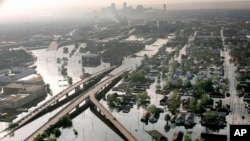As Hurricane Ida strengthened in the Gulf of Mexico, it became apparent the storm would strike Louisiana on August 29. The date was a haunting one for many New Orleans residents who survived Hurricane Katrina exactly 16 years earlier.
With the Category 4 Ida making landfall on such a notorious date, many anxious residents made comparisons to Katrina, one of the deadliest and most damaging hurricanes in U.S. history. There is no doubt Ida has caused significant damage to lives and infrastructure in southeastern Louisiana. There are, however, substantial differences between the two hurricanes.
Here is a closer look at some of those distinctions and their effects on millions of victims.
Wind strength
In 2005, Katrina arrived in Louisiana as a Category 3 storm. This week, Ida struck as a Category 4, and nearly a Category 5. Ida hit land at Port Fourchon — only 80 kilometers (50 miles) west of Katrina’s landing — with sustained winds maxing out at 240 kpm (150 mph). It was the fifth-strongest hurricane to hit the continental United States. By comparison, Katrina made landfall with maximum sustained winds of 200 kpm (125 mph).
Ida’s winds decreased in intensity before reaching the New Orleans metropolitan area, but residents who remained in the city reported sitting in total darkness as their homes were battered by frightening winds for more than 10 consecutive hours.
“I’ve lived here my entire life, and Ida was the worst wind I’d ever experienced. It seemed like it would never end,” New Orleans resident Joe Frisard, who remained in the city until Tuesday, told VOA.
Casualties
Despite the higher-intensity winds, the most welcomed difference between the two hurricanes is that Ida resulted in far fewer lives lost. In 2005, Katrina killed more than 1,800 Americans, nearly 1,600 of whom were from Louisiana.
In the aftermath of Ida, four deaths have been reported so far. Two of those victims are from Mississippi, where torrential rain caused a highway to collapse. In Louisiana, there were two deaths. One person was struck by a falling tree outside the capital, Baton Rouge, while another was a driver who drowned in New Orleans.
The death toll is likely to rise as officials reach isolated communities, but the number won’t begin to approach that of Katrina.
Size of storm
While wind wasn’t as powerful during Katrina, the storm was much larger than Ida. Katrina generated dangerous tropical storm winds as far as 370 kilometers (230 miles) from its center, while Ida’s dangerous tropical storm winds were projected as far as 225 kilometers (140 miles) from its center.
The size of a hurricane can have a major impact on its ability to create a rise in seawater, known as storm surge. Katrina’s storm surge topped out at approximately 8.5 meters (28 feet) and was the primary reason for the death and destruction it caused.
The extent of Ida’s storm surge is not yet known, though it appears to be far less than Katrina’s levels. Some towns outside New Orleans’ flood protection system received devastating flooding, however. To the west, the suburb of LaPlace recently began a levee improvement project that remains unfinished. Water from Ida poured into the town from an engorged Lake Pontchartrain, requiring some residents to climb to their roofs and await rescue.
Successful flood protection system
Because New Orleans is surrounded by water, and much of the city sits below sea level, a series of levees and pumps are required to keep residents safe. Sixteen years ago, that system — then long in need of improvement — was overwhelmed. Surging waters submerged 80% of New Orleans.
In the years after Katrina, however, $14 billion was invested in the city’s flood protection system. On Sunday, with the storm approaching, Louisiana Governor John Bel Edwards told reporters that officials “feel very good about what’s inside the hurricane risk reduction system.”
The system worked. Rising waters from Ida were kept out by levees, while rainwater was expelled via a system of pumps and canals.
But less populous areas outside that protection system haven’t fared as well. Government officials and volunteer organizations such as the United Cajun Navy are still attempting water rescues for residents trapped by floodwater.
‘Catastrophic’ electrical failure
After Katrina, nearly all of New Orleans was without electricity. The most notable exception was the downtown center around the historic French Quarter.
This time, the city was left completely without power. Entergy Corporation, the private company that provides electricity to New Orleans, confirmed the only power in the city was coming from generators, citing “catastrophic transmission damage” for the failure. All eight transmission lines delivering power to the New Orleans area were down, including one tower that crumbled beside — and partially into — the Mississippi River.
Entergy announced Tuesday that 85,000 of the 1 million power outages had been restored, but thousands of residents still in New Orleans are struggling to deal with the intense summer heat without electricity and gasoline. It is expected that Louisianians in the hardest-hit areas could be waiting weeks for power to be restored.
“The whole city is almost dead,” David Nguyen, 55, of the Westbank section of New Orleans, told VOA’s Vietnamese Service on Tuesday about the lost power in New Orleans. “No electricity. Water is on and off. It’s a hot day, with the temperature over 90 degrees (32 degrees Celsius), but we don’t have gasoline to keep our generator running. ... If there is no gas tomorrow, I will have to take refuge in Florida.”
Damage total
The total damage associated with Ida won’t be known for some time. In the New Orleans area alone, a significant number of torn-off roofs and collapsed buildings have been reported. Some of the evacuees will return home to find trees and electrical infrastructure on or near their homes.
Still, according to preliminary estimates, this damage will not approach the $81 billion in property damage caused by Katrina.
That’s little solace to the thousands of New Orleanians trying to survive the brutal heat with no electricity and limited supplies of food, water and gasoline. Stores and restaurants in the area are giving away food from their powerless refrigerators before it spoils. But unless electricity is restored soon, those remaining in and around New Orleans could be facing a new, dangerous stage in this crisis.
VOA's Vietnamese Service contributed to this report.














